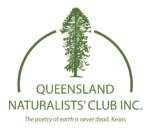
Club Meeting 17 June 2024 – CT White Lecture: Following the slime trail…the journey to Figuladra
17 June @ 7:00 pm - 9:30 pm

CT white Lecture: Following the slime trail….the journey to Figuladra
The 2024 CT White Lecture will be introduced by Dr John Stanisic and presented by Dr Lorelle Stanisic
Lorelle began voluntary work in the Queensland Museum in malacology in 2010. When she retired from education in 2016 she enrolled at Griffith University, gaining a master’s degree working on the tiny pinwheel snails of mid-eastern Queensland. During that time, Lorelle named around 30 new species of this diverse fauna and recently completed a PhD working on an interesting group of camaenids, a genus known as Figuladra.
Figuladra is an intriguing genus. Shells from this genus were first collected in the early 1800s and first described in 1845. Between then and 1940, a number of species and subspecies were described. However, since these were described solely on shell character, and these shells sometimes had spurious localities or very generalised ones such as ‘northern Australia’, there was a definite taxonomic impediment to understanding this genus.
Lorelle started out by undertaking an historical aspect; locating where type species resided which included six other museums throughout the world. Type localities for all species described prior to 1940 were designated. The next step involved working out if the known species and subspecies were actually part of genus Figuladra. Solving this question involved an integrated taxonomy incorporating molecular analyses, anatomical dissections, measurements of shells and electron microscopy of radula (teeth and jaws) and shell sculpture. When Covid hit in 2020, John and Lorelle set up their own dissection lab under their house and continued to work from there.
It soon became clear that Figuladra was polymorphic, a position proven through both molecular analyses and the dissection of the genital anatomy of numerous specimens. Thus, Euryladra mattea and Brigaladra volgiola found themselves in two new genera. Further to this, it was discovered that E. mattea, whose habitat was eucalypt forest and B. volgiola, found in semi-evergreen vine thicket west of the Great Dividing Range, did not share the preferred habitat of true Figuladra, the microphyll vine thickets and vine forests of the coast east of the Great Dividing Range.
Of the remaining species, it was clear that there were no subspecies and that each species had a relatively well defined habitat. Thus four new species were named and eleven other species fully described. This journey culminated in the publication of four papers, several articles and elements of the study incorporated into the Stanisic’s most recent publication, ‘A Guide to the land Snails of Australia’.
A similar journey continues today, not only with John and Lorelle Stanisic at the Queensland Museum, but in malacology labs across the world. The slime trail endures for the future.
Details
- Date:
- 17 June
- Time:
-
7:00 pm - 9:30 pm
- Event Category:
- Meetings
Venue
- Toowong Uniting Church Hall
-
82 Sherwood Road
Toowong, Queensland 4066 Australia + Google Map
